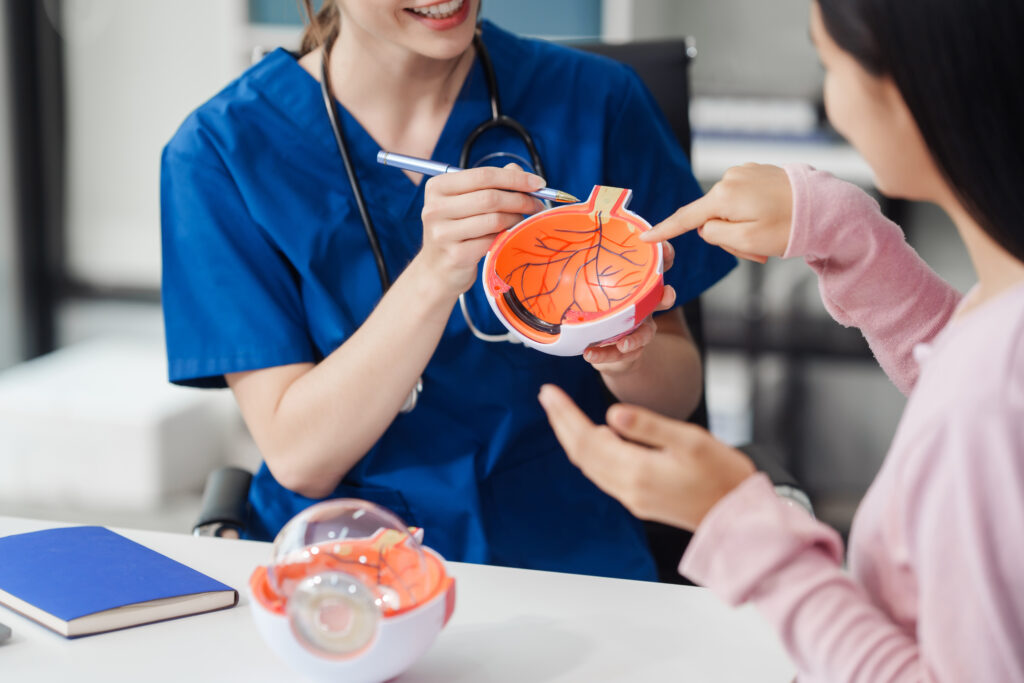
Padiatric
Cataract
What is a Pediatric Cataract?
A pediatric cataract is a clouding of the natural lens of the eye in infants or young children, which can cause blurry or impaired vision. Unlike adult cataracts, which develop gradually due to aging, pediatric cataracts can be present at birth (congenital) or develop in early childhood due to various factors.
At Sanjeevani Netralaya, we understand how crucial clear vision is for a child’s overall development and learning. Our pediatric eye specialists are dedicated to diagnosing and treating cataracts in children to ensure the best possible visual outcomes.
What Causes Pediatric Cataracts?
Pediatric cataracts can result from a variety of factors, including:
- Congenital Cataracts: Present at birth and may be due to genetic factors, developmental issues, or infections during pregnancy (like rubella, chickenpox, or herpes).
- Inherited Conditions: Certain genetic disorders, such as Down syndrome or metabolic diseases like galactosemia, can increase the risk of cataracts.
- Trauma: Eye injuries or trauma can lead to the formation of cataracts in children.
- Infections and Inflammation: Eye infections or inflammation, like uveitis, can also cause cataracts.
- Other Medical Conditions: Diseases such as diabetes or prolonged use of medications like steroids may contribute to cataract development in children.
Recognizing the Symptoms of Pediatric Cataracts
Detecting cataracts in children can be challenging, especially if the child is too young to express vision problems. However, some signs may indicate the presence of a cataract:
- White or Gray Pupil: A visible cloudiness or whiteness in the pupil, also known as a “white reflex.”
- Squinting or Misalignment of Eyes (Strabismus): The eyes may appear misaligned, or the child may frequently squint.
- Poor Vision or Lack of Focus: The child may have difficulty following objects, recognizing faces, or showing less interest in visual stimuli.
- Rapid Eye Movements (Nystagmus): Uncontrolled movements of the eyes may occur.
- Light Sensitivity (Photophobia): Increased sensitivity to light or discomfort in bright conditions.
If you notice any of these signs, it is essential to schedule an eye examination at Sanjeevani Netralaya as soon as possible to assess your child’s vision.
Did You Know?
Early diagnosis and treatment of pediatric cataracts are crucial for preventing permanent vision loss. A child’s visual system is still developing, especially in the first few years of life. Untreated cataracts can lead to amblyopia (lazy eye) or other visual impairments.
Diagnosis of Pediatric Cataracts
At Sanjeevani Netralaya, our pediatric ophthalmologists use advanced diagnostic tools and techniques to detect cataracts in children, including:
- Visual Acuity Test: To measure the clarity of vision in each eye, suitable for older children.
- Retinoscopy and Refraction: To determine if there is a need for corrective lenses.
- Slit-Lamp Examination: A specialized microscope to examine the eye’s structures in detail.
- Dilated Eye Exam: Using eye drops to widen the pupil, allowing for a thorough examination of the lens, retina, and optic nerve.
- Ocular Ultrasound: May be used to assess the internal structures of the eye if the cataract is very dense.
FAQs
Is cataract surgery safe for children?
Yes, cataract surgery is generally safe for children when performed by experienced pediatric ophthalmologists. It is a well-established procedure that offers significant benefits in preserving and restoring vision.
How soon should a cataract in a child be treated?
Prompt treatment is crucial for preventing permanent vision loss. If a cataract is detected, our specialists will guide you on the best timing for surgery based on your child’s specific needs.
What is the recovery time after cataract surgery?
Most children recover quickly from cataract surgery, but the complete healing process may take a few weeks to a few months. Regular follow-up visits will ensure that the eye is healing properly.
Can both eyes be treated at the same time?
In some cases, both eyes can be treated in a single surgical session, but this decision will depend on the child’s overall health, the severity of the cataracts, and other factors.

